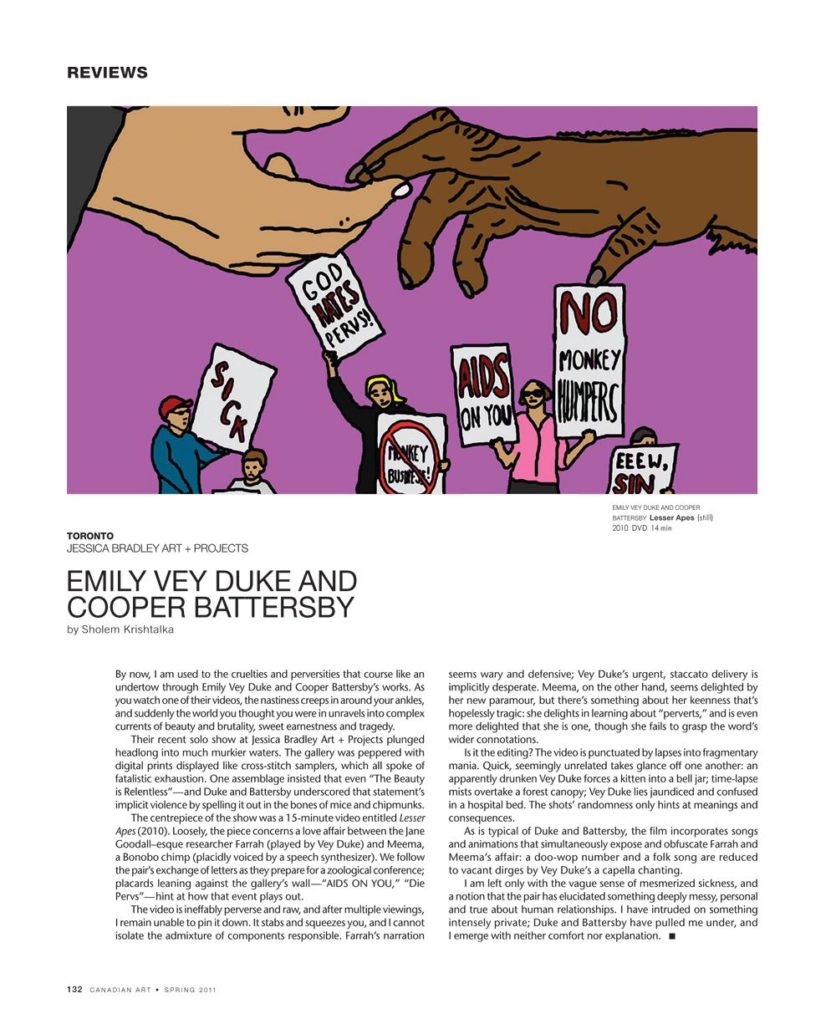By now, I am used to the cruelties and perversities that course like an undertow through Emily Vey Duke and Cooper Battersby’s works. As you watch one of their videos, the nastiness creeps in around your ankles, and suddenly the world you thought you were in unravels into complex currents of beauty and brutality, sweet earnestness and tragedy.
Their recent solo show at Jessica Bradley Art + Projects plunged headlong into much murkier waters. The gallery was peppered with digital prints displayed like cross-stitch samplers, which all spoke of fatalistic exhaustion. One assemblage insisted that even “The Beauty is Relentless”—and Duke and Battersby underscored that statement’s implicit violence by spelling it out in the bones of mice and chipmunks.
The centrepiece of the show was a 15-minute video entitled Lesser Apes (2010). Loosely, the piece concerns a love affair between the Jane Goodall–esque researcher Farrah (played by Vey Duke) and Meema, a Bonobo chimp (placidly voiced by a speech synthesizer). We follow the pair’s exchange of letters as they prepare for a zoological conference; placards leaning against the gallery’s wall—“AIDS ON YOU,” “Die Pervs”—hint at how that event plays out.
The video is ineffably perverse and raw, and after multiple viewings, I remain unable to pin it down. It stabs and squeezes you, and I cannot isolate the admixture of components responsible. Farrah’s narration seems wary and defensive; Vey Duke’s urgent, staccato delivery is implicitly desperate. Meema, on the other hand, seems delighted by her new paramour, but there’s something about her keenness that’s hopelessly tragic: she delights in learning about “perverts,” and is even more delighted that she is one, though she fails to grasp the word’s wider connotations.
Is it the editing? The video is punctuated by lapses into fragmentary mania. Quick, seemingly unrelated takes glance off one another: an apparently drunken Vey Duke forces a kitten into a bell jar; time-lapse mists overtake a forest canopy; Vey Duke lies jaundiced and confused in a hospital bed. The shots’ randomness only hints at meanings and consequences.
As is typical of Duke and Battersby, the fi lm incorporates songs and animations that simultaneously expose and obfuscate Farrah and Meema’s affair: a doo-wop number and a folk song are reduced to vacant dirges by Vey Duke’s a capella chanting.
I am left only with the vague sense of mesmerized sickness, and a notion that the pair has elucidated something deeply messy, personal and true about human relationships. I have intruded on something intensely private; Duke and Battersby have pulled me under, and I emerge with neither comfort nor explanation.
This is an article from the Spring 2011 issue of Canadian Art. To read more from this issue, please visit its table of contents.









